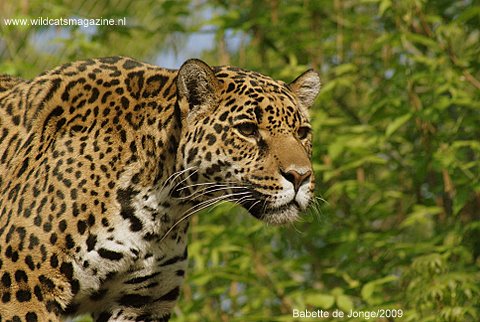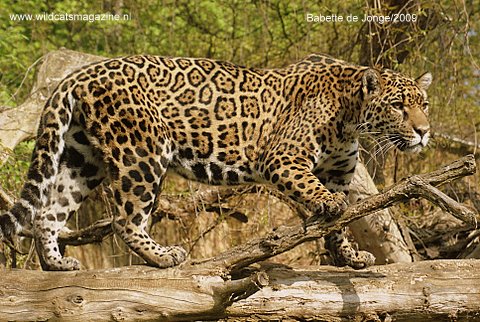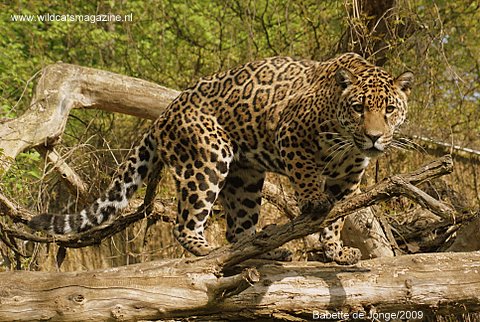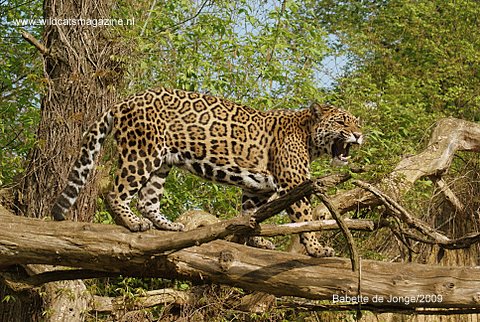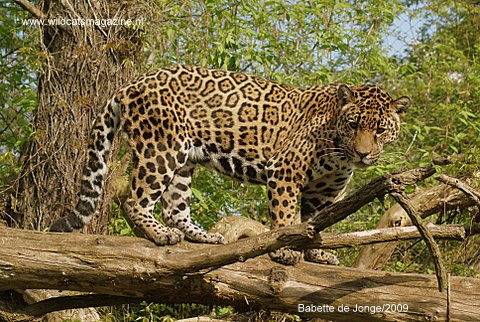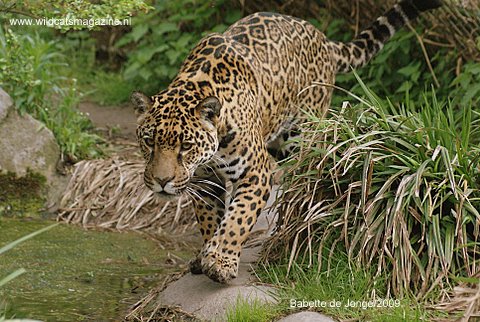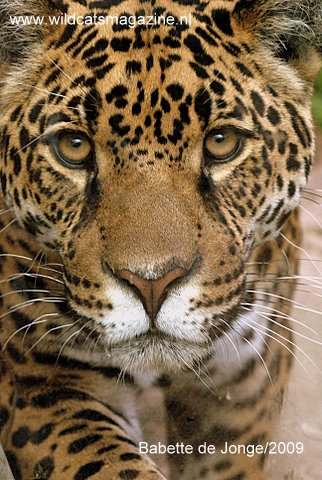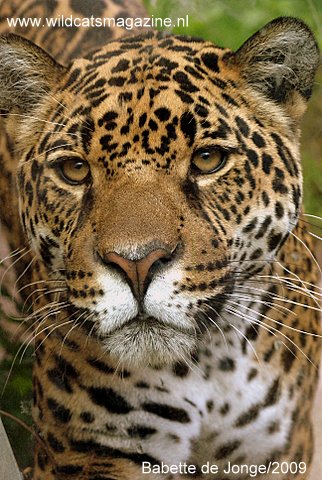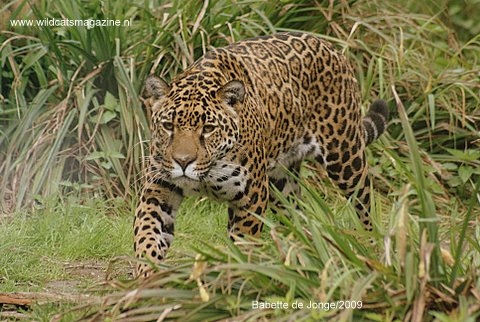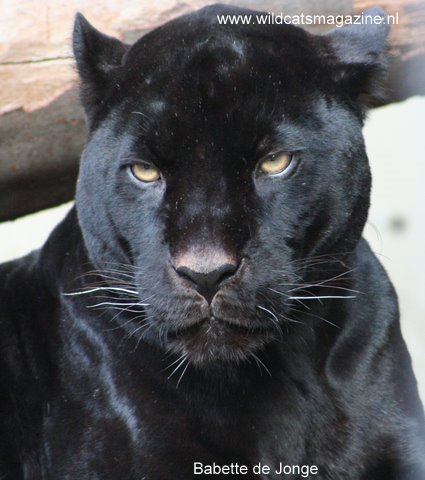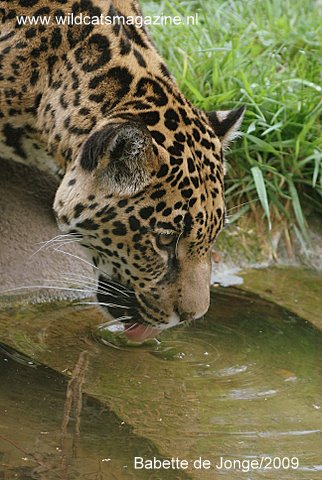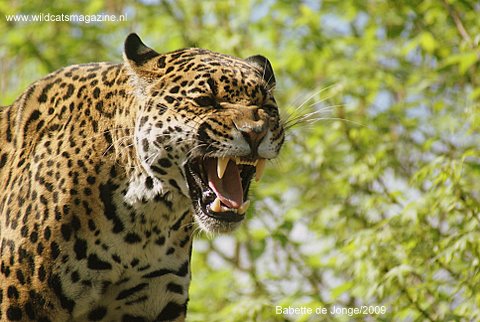The jaguar is one of the big cats in the Panthera genus.. It is the only Panthera found in the Americas. The jaguar is the third-largest big cat (feline) after the tiger and the lion, and the largest and most powerful feline in the Western Hemisphere. The jaguar’s present range extends from Mexico across much of Central America and south to Paraguay and northern Argentina. Apart from a known and possibly breeding population in Arizona, the cat has largely been extirpated from the U.S.A. since the early 1900s.
The jaguar is a near threatened species and its numbers are declining. Threats include habitat loss and fragmentation. While international trade in jaguars or their parts is prohibited, the cat is still regularly killed by humans, particularly in conflicts with ranchers and farmers in South America.
The adult jaguar is an apex predator, meaning that it exists at the top of its food chain and is not preyed on in the wild. The jaguar has also been termed a keystone species, as it is assumed, through controlling the population levels of prey such as herbivorous and granivorous mammals, apex felids maintain the structural integrity of forest systems. However, accurately determining what effect species like the jaguar have on ecosystems is difficult, because data must be compared from regions where the species is absent as well as its current habitats, while controlling for the effects of human activity. It is accepted that mid-sized prey species undergo population increases in the absence of the keystone predators and it has been hypothesized that this has cascading negative effects. However, field work has shown this may be natural variability and that the population increases may not be sustained. Thus, the keystone predator hypothesis is not favoured by all scientists.
Jaguar populations are currently declining. The animal is considered Near Threatened by the International Union for Conservation of Nature and Natural Resources, meaning it may be threatened with extinction in the near future. The loss of parts of its range, including its virtual elimination from its historic northern areas and the increasing fragmentation of the remaining range, have contributed to this status.
The major risks to the jaguar include deforestation across its habitat, increasing competition for food with human beings, poaching, hurricanes in northern parts of its range, and the behaviour of ranchers who will often kill the cat where it preys on livestock. When adapted to the prey, the jaguar has been shown to take cattle as a large portion of its diet; while land clearance for grazing is a problem for the species, the jaguar population may have increased when cattle were first introduced to South America as the animals took advantage of the new prey base. This willingness to take livestock has induced ranch owners to hire full-time jaguar hunters, and the cat is often shot on sight.
The jaguar is regulated as an Appendix I species under Cites: all international trade in jaguars or their parts is prohibited. All hunting of jaguars is prohibited in Argentina, Belize, Colombia, French Guiana, Honduras, Nicaragua, Panama, Paraguay, Suriname, the United States (where it is listed as endangered under the Endangered Species Act), Uruguay and Venezuela. Hunting of jaguars is restricted to “problem animals” in Brazil, Costa Rica, Guatemala, Mexico and Peru, while trophy hunting is still permitted in Bolivia. The species has no legal protection in Ecuador or Guyana. Current conservation efforts often focus on educating ranch owners and promoting ecotourism. The jaguar is generally defined as an umbrella species – a species whose home range and habitat requirements are sufficiently broad that, if protected, numerous other species of smaller range will also be protected. Umbrella species serve as “mobile links” at the landscape scale, in the jaguar’s case through predation. Conservation organizations may thus focus on providing viable, connected habitat for the jaguar, with the knowledge that other species will also benefit.
The jaguar also has an effect on other predators. The jaguar and the cougar, the next largest feline of the Americas, are often sympatric (related species sharing overlapping territory) and have often been studied in conjunction. Where sympatric with the jaguar, the cougar is smaller than normal and is smaller than the local jaguars. The jaguar tends to take larger prey and the cougar smaller, reducing the latter’s size. This situation may be advantageous to the cougar. Its broader prey niche, including its ability to take smaller prey, may give it an advantage over the jaguar in human-altered landscapes; while both are classified as near-threatened species, the cougar has a significantly larger current distribution.
Like most cats, the jaguar is solitary outside mother-cub groups. Adults generally meet only to court and mate (though limited non-courting socialization has been observed anecdotally) and carve out large territories for themselves. Female territories, from 25 to 40 square kilometers in size, may overlap, but the animals generally avoid one another. Male ranges cover roughly twice as much area, varying in size with the availability of game and space, and do not overlap. Scrape marks, urine, and faeces are used to mark territory.
Like the other big cats, the jaguar is capable of roaring (the male more powerfully) and does so to warn territorial and mating competitors away; intensive bouts of counter-calling between individuals have been observed in the wild. Their roar often resembles a repetitive cough, and they may also vocalize mews and grunts. Mating fights between males occur, but are rare, and aggression avoidance behaviour has been observed in the wild. When it occurs, conflict is typically over territory: a male’s range may encompass that of two or three females, and he will not tolerate intrusions by other adult males. The jaguar is often described as nocturnal, but is more specifically crepuscular (peak activity around dawn and dusk). Both sexes hunt, but males travel farther each day than females, befitting their larger territories. The jaguar may hunt during the day if game is available and is a relatively energetic feline, spending as much as 50-60% of its time active. The jaguar’s elusive nature and the inaccessibility of much of its preferred habitat make it a difficult animal to sight, let alone study.
Like all cats, the jaguar is a carnivore, feeding only on meat. It is an opportunistic hunter and its diet encompasses 87 species. The jaguar prefers large prey and will take deer, capybara, tapirs, peccaries, dogs, foxes and sometimes even anacondas and caiman. However, the cat will eat any small species that can be caught, including frogs, mice, birds, fish, sloths, monkeys and turtles. Some jaguars will also take domestic livestock, including adult cattle and horses.
While the jaguar employs the deep-throat bite-and-suffocation technique typical among Panthera, it prefers a killing method unique amongst cats: it pierces directly through temporal bones of the skull between the ears of prey (especially the Capybara) with its canine teeth, piercing the brain. This may be an adaptation to “cracking open” turtle shells; following the late Pleistocene extinctions, armoured reptiles such as turtles would have formed an abundant prey base for the jaguar. The skull bite is employed with mammals in particular; with reptiles such as caiman, the jaguar may leap on to the back of the prey and sever the cervical vertebrae, immobilizing the target. While capable of cracking turtle shells, the jaguar may simply reach into the shell and scoop out the flesh. With prey such as dogs, a paw swipe to crush the skull may be sufficient.
The jaguar is a stalk-and-ambush rather than a chase predator. The cat will walk slowly down forest paths, listening for and stalking prey before rushing or ambushing. The jaguar attacks from cover and usually from a target’s blind spot with a quick pounce; the species’ ambushing abilities are considered nearly peerless in the animal kingdom by both indigenous people and field researchers, and are probably a product of its role as an apex predator in several different environments. The ambush may include leaping into water after prey, as a jaguar is quite capable of carrying a large kill while swimming; its strength is such that carcasses as large as a heifer can be hauled up a tree to avoid flood levels.
On killing prey, the jaguar will drag the carcass to a thicket or other secluded spot. It begins eating at the neck and chest, rather than the midsection. The heart and lungs are consumed, followed by the shoulders. The daily food requirement of a 34 kilogram animal, at the extreme low end of the species’ weight range, has been estimated at 1.4 kilograms. For captive animals in the 50-60 kilogram range, more than 2 kilograms of meat daily is recommended. In the wild, consumption is naturally more erratic; wild cats expend considerable energy in the capture and kill of prey, and may consume up to 25 kilograms of meat at one feeding, followed by periods of famine. Unlike all other species in the Panthera genus, jaguars very rarely attack humans. Most of the scant cases where jaguars turn to taking a human show that the animal is either old with damaged teeth or is wounded. Sometimes, if scared, jaguars in captivity may lash out at zookeepers.
This spotted cat most closely resembles the leopard physically, although it is usually larger and of sturdier build and its behavioural and characteristics are closer to those of the tiger. While dense rainforest is its preferred habitat, the jaguar will range across a variety of forested and open terrain. It is strongly associated with the presence of water and is notable, along with the tiger, as a feline that enjoys swimming. The jaguar is a largely solitary, stalk-and-ambush predator, and is opportunistic in prey selection.
The base coat of the jaguar is generally a tawny yellow, but can range to reddish-brown and black. The cat is covered in rosettes for camouflage in its jungle habitat. The spots vary over individual coats and between individual Jaguars: rosettes may include one or several dots, and the shape of the dots varies. The spots on the head and neck are generally solid, as are those on the tail, where they may merge to form a band. The underbelly, throat and outer surface of the legs and lower flanks are white.
A condition known as melanism occurs in the species. The melanistic form is less common than the spotted form (it occurs at about six percent of the population) of jaguars in their South American range have been reported to possess it-and is the result of a dominant allele. Jaguars with melanism appear entirely black, although their spots are still visible on close examination. Melanistic Jaguars are informally known as black panthers, but do not form a separate species. Rare albino individuals, sometimes called white panthers, occur among jaguars, as with the other big cats.
While the jaguar closely resembles the leopard, it is sturdier and heavier, and the two animals can be distinguished by their rosettes: the rosettes on a jaguar’s coat are larger, fewer in number, usually darker, and have thicker lines and small spots in the middle that the leopard lacks. Jaguars also have rounder heads and shorter, stockier limbs compared to leopards.
Jaguar females reach sexual maturity at about two years of age, and males at three or four. The cat is believed to mate throughout the year in the wild, although births may increase when prey is plentiful. Research on captive male jaguars supports the year-round mating hypothesis, with no seasonal variation in semen traits and ejaculatory quality; low reproductive success has also been observed in captivity. Female estrous is 6-17 days out of a full 37-day cycle, and females will advertise fertility with urinary scent marks and increased vocalization. Both sexes will range more widely than usual during courtship.
Mating pairs separate after the act, and females provide all parenting. The gestation period lasts 93-105 days; females give birth to up to four cubs, and most commonly to two. The mother will not tolerate the presence of males after the birth of cubs, given a risk of infant cannibalism; this behaviour is also found in the tiger.
The young are born blind, gaining sight after two weeks. Cubs are weaned at three months but remain in the birth den for six months before leaving to accompany their mother on hunts. They will continue in their mother’s company for one to two years before leaving to establish a territory for themselves. Young males are at first nomadic, jostling with their older counterparts until they succeed in claiming a territory. Typical lifespan in the wild is estimated at around 12-15 years; in captivity, the jaguar lives up to 23 years, placing it among the longest-lived cats.

